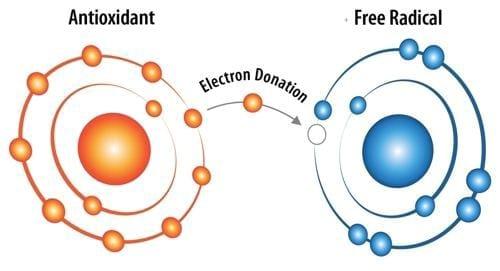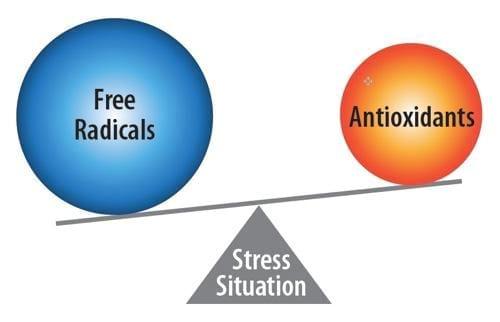Oxidative stress: Impact on dairy health and immune function
Published: August 10, 2015
By: Julia Hamann, D.V.M.
Oxidative stress is a normal occurrence during the immune system’s inflammatory response to infection or injury. Inflammation plays a vital role in the body’s response to pathogens and tissue damage. However, considerable evidence now points to oxidative stress from chronic inflammation as a contributing factor in a number of health and production disorders in cattle.
Research suggests that oxidative stress in dairy cattle is a significant underlying factor in dysfunctional host immune and inflammatory responses, which can increase susceptibility to a variety of health disorders (Sordillo and Aitken, 2009). These disorders can include sepsis, mastitis, acidosis, ketosis, enteritis, pneumonia, and other diseases (Celi, 2010).
Early studies had suggested that supplementation with certain antioxidants could ameliorate the severity of metabolic and infectious diseases (Miller et al., 1993). Since then, researchers have sought to better understand the immune inflammatory response, oxidative stress, and the potential use of dietary antioxidants in dairy cattle. The need for such products has grown with the increasing productivity of modern dairy cows.
Inflammation: Normal and necessary in balance
Inflammation is a necessary component of the immune system. It is an initial response to harmful stimuli, such as infection or injury, and plays a key role in the body’s response to pathogens and tissue damage. Inflammation helps in the elimination of pathogens and the recruitment of immune cells (macrophages and neutrophils) to sites of injury to remove infected or damaged cells. This type of inflammation – acute inflammation – occurs as the “acute phase response” and is an important part of a healthy response to infection or injury.
However, inflammation that persists following the initial stimuli and response is chronic inflammation, which can be harmful to the animal. The normal inflammatory response generates oxidative stress, which occurs when oxidant activity exceeds the neutralizing capacity of available antioxidants.

Oxidants include “free radicals” formed when oxygen interacts with certain molecules, resulting in highly reactive atoms or groups of atoms with an odd number of electrons, including “free” electrons available for pairing. Antioxidants are compounds that can “donate” an electron, thereby neutralizing oxidative effects. Antioxidants may delay, prevent, or remove oxidative damage to a target molecule (Halliwell and Gutteridege, 2007).
Virtually every metabolic process in the animal can create oxidative stress. For this reason, certain essential nutrients, such as vitamin E and selenium, have important antioxidant functions.
ROS formation and oxidative damage
Reactive oxygen species (ROS) are the most abundant free radicals in a biological system. ROS are formed continuously as normal by-products of cellular metabolism and, in low concentrations, are essential to several physiological processes. Therefore, a certain level of ROS is desirable.
However, once formed, these highly reactive radicals can start a chain reaction, like dominoes falling. Their main biological targets include lipids, proteins, and other macromolecules. The primary danger of ROS comes from the damage they can do when they react with important cellular components such as DNA or the cell membrane. If this occurs, cells may function poorly or die.
Antioxidant defenses
To prevent free radical damage, the body has an antioxidant defense system. Endogenous antioxidants can be divided into three major groups:
- Enzymatic, the main form of intracellular antioxidant defense;
- Non-enzymatic protein, primarily found in plasma; and
- Non-enzymatic low molecular weight, found in plasma and in extracellular and intracellular fluids.
Selenium (Se) dependent antioxidant enzymes are the most widely studied systems with respect to dairy cattle health and well-being. Many of the beneficial health effects of Se are mediated by antioxidant selenoenzymes. Cytosolic glutathione peroxidase (GPX1) is the selenoenzyme most often associated with antioxidant function in cattle. GPX1 is often used as diagnostic tool when assessing Se status in dairy cows (Celi, 2011).
Oxidative stress and disease.
The majority of health problems in the dairy cow occur around parturition and relate to the cow's difficulty adapting to the nutrient needs for lactation. The relationship between an overall loss of antioxidant potential and the physiological changes associated with parturition is well established for both humans and dairy cows (Bernabucci et al., 2005; Sordillo et al., 2007). Oxidative stress during the transition period may be a major underlying cause of inflammatory and immune dysfunction in dairy cattle as supported by both in vivo and in vitro studies (Sordillo and Aitken, 2009).
The newborn calf depends on the acquisition of adequate amounts of high quality colostrum soon after birth for protection against diseases. However, colostrum is also a source of ROS (Albera and Kankofer, 2011). Intrinsic production of ROS also increases after birth, so the combination of colostral and intrinsic ROS could
overwhelm the antioxidant capacity of the calf.
overwhelm the antioxidant capacity of the calf.

If the production of ROS overwhelms the antioxidant capacity of the neonate, oxidative stress can develop.
Oxidative stress plays a key role in the initiation and maintenance of conditions such as diarrhea and pneumonia (Ranjan et al., 2006; Lykkesfeldt and Svendsen, 2007; Sordillo and Aitken, 2009).

Research has shown that the redox balance of the colostrum has a significant effect on calf oxidative status and on passive immune transfer (as measured by calf serum IgG concentration), which indicates that the oxidative-antioxidative profile of colostrum should be measured when evaluating colostrum quality. Researchers found that the highest risk of oxidative stress occurred when calves were fed artificial milk replacer, suggesting that calves should be supplemented with antioxidants during this period in order to minimize any harmful consequences of high ROS generation (Abuelo et al., 2014).
Dairy management practices and genetic selection to maximize milk production can increase metabolic stress associated with parturition and milk production. As production demands continue to intensify within the dairy industry, the antioxidant requirements of cows are likely to increase.
There is considerable evidence to support that oxidative stress contributes to a number of health and production disorders in cattle, but there is still a great deal to be discovered. A better understanding of how antioxidants may prevent immune dysfunction and oxidative damage to host tissues may lead to more effective strategies to avoid disease in the dairy cattle (Sordillo and Aitken, 2009).
Dietary antioxidants are likely to play an increasingly important role in dairy feeding, especially as dairy producers seek to optimize the genetic potential of their high-producing cows.
References
- Abuelo, A., Pérez-Santos, M., Hernádez, J., Castillo, C., 2014. Effect of colostrum redox balance on the oxidative status of calves during the first 3 months of life and the relationship with passive immune acquisition. The Veterinary J. 199: 295-299.
- Albera, E., Kankofer, M., 2011. The comparison of antioxidative/oxidative profile in blood, colostrum and milk of early post-partum cows and their newborns. Reproduction in Domestic Animals 46, 763–769.
- Bernabucci, U., Ronchi, B., Lacetera, N., Nardone, A., 2005. Influence of body condition score on relationships between metabolic status and oxidative stress in periparturient dairy cows. J. Dairy Sci. 88: 2017-2026.
- Celi, P., 2011. Biomarkers of oxidative stress in ruminant medicine. Review article. Immunopharmacology and Immunotoxicology. 33(2): 233-240.
- Halliwell, B., Gutteridge, J.M.C., 2007. Free Radicals in Biology and Medicine, 4th ed. Oxford University Press. 851.
- Lykkesfeldt, J., Svendsen, O. 2007. Oxidants and antioxidants in disease: oxidative stress in farm animals. Vet. J. 173: 502-511.
- Miller, J.K., Brzezinska-Slebodzinska, E., Madsen, F.C., 1993. Oxidative stress, antioxidants, and animal function. J. Dairy Sci. 76: 2812-2823
- Ranjan, R., Naresh, R., Patra, R.C., Swarup, D., 2006. Erythrocyte lipid peroxides and blood zinc and copper concentrations in acute undifferentiated diarrhea in calves. Veterinary Research Communications. 30: 249-254.
- Sordillo, L.M., O’Boyle, N., Gandy, J.C., Corl, C.M., Hamilton, E., 2007. Shifts in thioredoxin reductase activity and oxidant status in mononuclear cells obtained from transition dairy cattle. J. Dairy Sci. 90: 1186-1192.
- Sordillo, L.M., Aitken, S.L., 2009. Impact of oxidative stress on the health and immune function of dairy cattle. Veterinary Immunology and Immunopathology. 128: 104-109.
Related topics
Authors:
Join to be able to comment.
Once you join Engormix, you will be able to participate in all content and forums.
* Required information
Would you like to discuss another topic? Create a new post to engage with experts in the community.
Create a post10 de octubre de 2015
Hi there! I am a student in the UK and I am completing a research project on dairy farming, particularly investigating the impacts of reproductive technology on increasing milk yield, in comparison to nutritional and environmental factors. I was wondering if you would be kind enough to complete a questionnaire I have generated to gather primary research:
https://www.surveymonkey.com/r/63C36VL
Thank you!
Exotic Biosolutions
8 de octubre de 2015
This a wonderful article on the impact of oxidative stress.It is a hidden problem and generally goes noticed by a vet.
A must read presentation.







.jpg&w=3840&q=75)